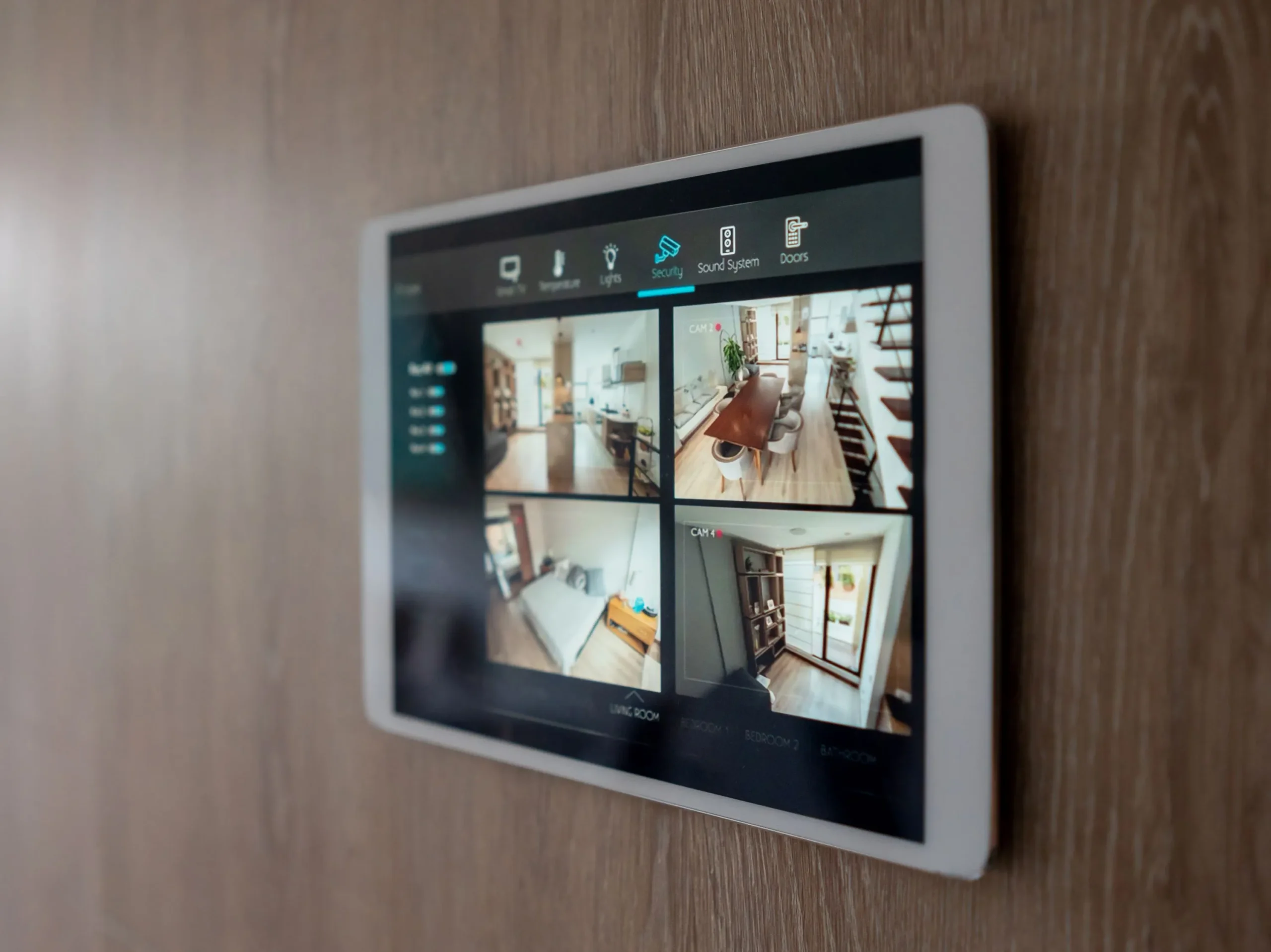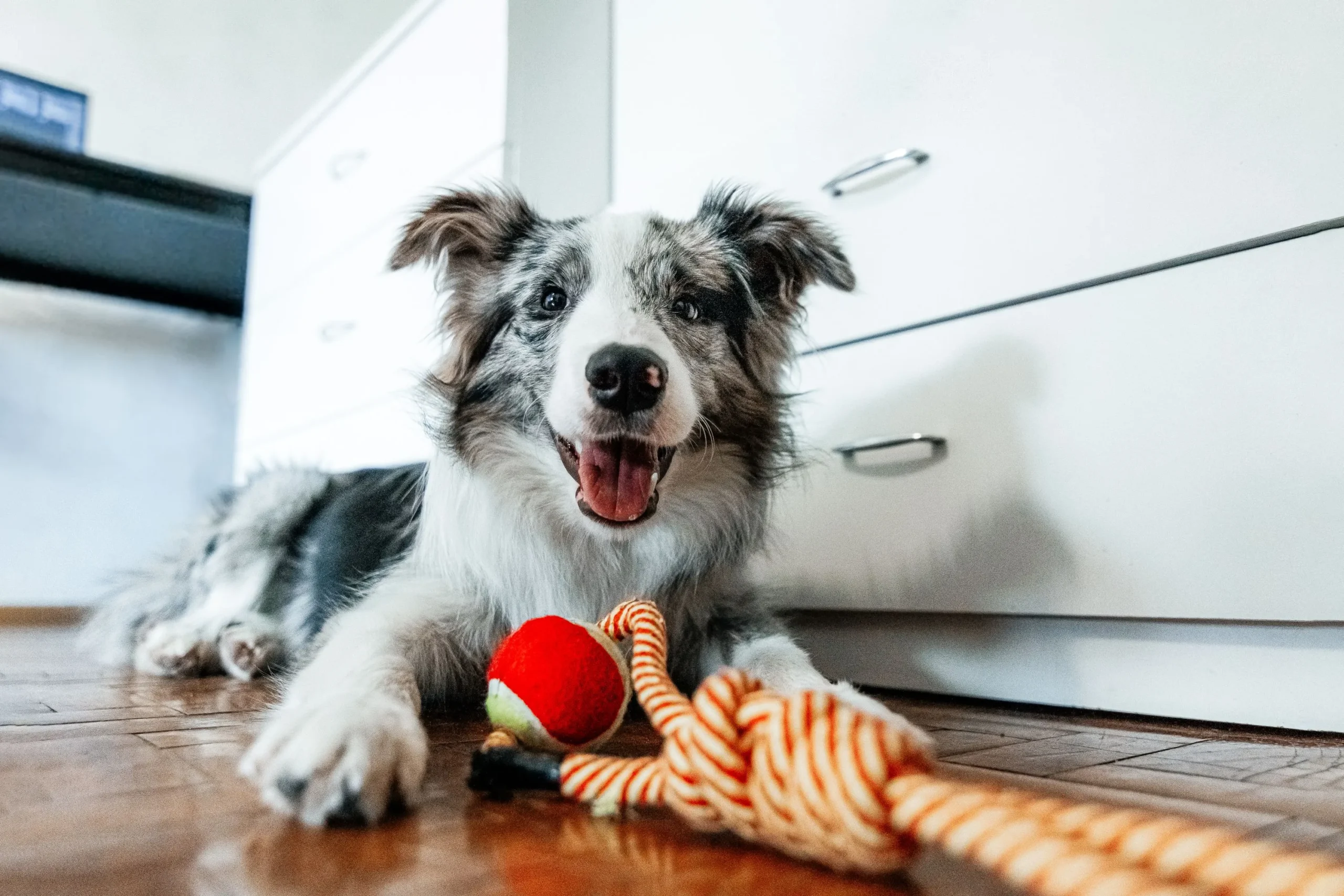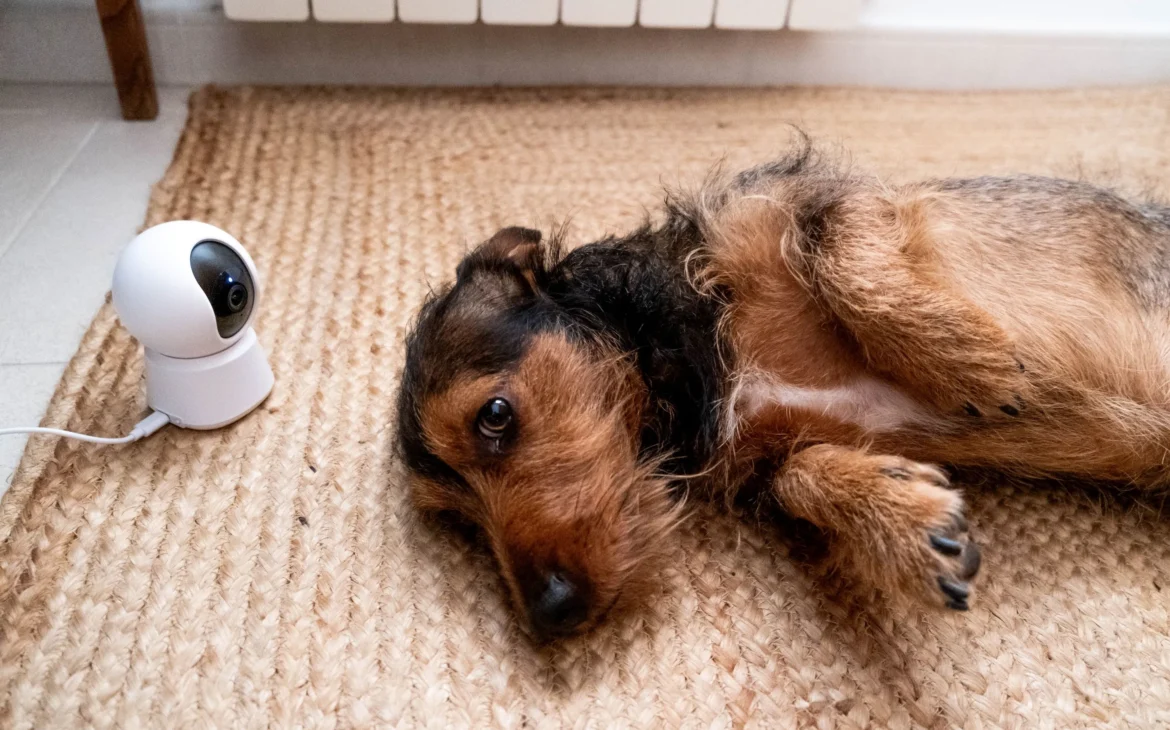“Take Your Dog to Work Day,” which rolls around each year on June 20th, is a truly special occasion. For many of us, it’s a delightful glimpse into a world where our furry best friends are by our sides, snoozing under our desks or offering a comforting paw during a stressful meeting. It’s a day filled with wagging tails in the breakroom and a collective understanding of the joy dogs bring to our lives. But then the day ends, and reality sets in. What about all those other days? The approximately 250 workdays a year when your beloved canine companion has to hold down the fort at home while you’re out conquering the world (or at least, your inbox)?
If you’re like most dedicated dog owners, the thought of leaving your pup alone can be accompanied by a pang of guilt. We worry if they’re lonely, bored, or anxious. Are they staring forlornly out the window, or are they finding creative (and possibly destructive) ways to entertain themselves? This concern is natural; our dogs are family, and their well-being is a top priority. The good news is that we live in an age of incredible technological advancement. Modern smart home technology offers a powerful and comforting way to bridge that physical distance, acting as your virtual presence and extending your loving care even when you can’t physically be there.
Imagine being able to check in on your pup with a crystal-clear video feed, offer a reassuring word through a two-way speaker, or even toss them a treat for being a good boy or girl–all from your smartphone, wherever you are. This isn’t science fiction; it’s the reality of today’s smart pet tech. Let’s explore the exciting world of smart home solutions designed to keep your dog happy, safe, and engaged while you’re away, ultimately giving you invaluable peace of mind. We’ll delve into the types of technology available, how they address common canine concerns, and importantly, how a robust internet connection forms the backbone of this connected care.
Key takeways
- Bridge the distance: Smart home technology helps you stay connected with your dog when you’re not home, easing owner guilt and help ensures your pup feels less alone.
- Monitor and interact: See, hear, talk to, and even toss treats to your dog with smart cameras and treat dispensers, offering reassurance and positive reinforcement from anywhere.
- Combat boredom and anxiety: Help keep your dog mentally stimulated and calm with interactive toys, puzzle feeders, and smart controls for lighting, sound, and climate.
- Ensure safety and comfort: Beyond interaction, smart sensors (smoke, CO, motion, gate) and climate control help provide a safe, comfortable environment for your pet.
- Reliable internet is key: A fast, stable internet connection, like fiber, is crucial for all your smart pet devices to function seamlessly and reliably.
Feel free to jump to areas that interest you the most:
- Understanding your furry friend: Why leaving them can be ruff
- Your eyes, ears, and voice at home: Smart monitoring for ultimate peace of mind
- Banishing boredom and boosting bliss: Interactive tech for a happy, engaged pup
- The unsung hero: Why your internet connection powers your peace of mind (and your pup’s playtime!)
- Getting started: Choosing and Integrating smart tech for your four-legged family member
- A happier pup, a more connected you.
Understanding your furry friend: Why leaving them can be ruff
Before we jump into the exciting tech, it helps to understand why some dogs find alone time challenging. It’s not because they’re trying to be difficult; often, it’s a manifestation of their inherent social nature or specific anxieties.

Decoding doggy dilemmas: What happens when you’re away?
Dogs are inherently social creatures. For thousands of years, they’ve been our companions, living in close-knit family groups. Being left alone can feel unnatural to them, leading to a range of responses:
- Boredom: Just like humans, dogs need mental stimulation. Without it, a long day alone can feel endless. A bored dog is often a dog looking for a “job” to do, which might manifest as chewing on your favorite shoes, redecorating the sofa with its stuffing, or exploring the fascinating contents of the kitchen bin. It’s not malice; it’s often a quest for entertainment.
- Loneliness: Our dogs form incredibly strong bonds with us. Your absence can genuinely make them feel sad and lonely. They miss your presence, your scent, and the comfort of your companionship. This can lead to listlessness or, conversely, attention-seeking behaviors when you return.
- Separation anxiety: For some dogs, being left alone triggers more than just boredom or loneliness; it can cause genuine panic and distress. Separation anxiety is a recognized condition where dogs exhibit extreme stress responses when separated from their owners. This can include:
- Excessive barking, howling, or whining
- Destructive behavior (often focused on exit points like doors and windows)
- Pacing
- Attempts to escape
- Urinating or defecating indoors, even if house-trained
- Excessive salivation or panting It’s crucial to differentiate between occasional boredom-induced mischief and true separation anxiety, which often requires a more comprehensive approach involving behavior modification, and sometimes veterinary consultation, in addition to supportive tech.
- Lack of physical activity: While some dogs are champion nappers, many need regular outlets for their energy. Being cooped up all day without exercise can lead to restlessness and contribute to other behavioral issues.
Understanding these potential challenges is the first step. It allows us to empathize with our pets and appreciate how smart home technology isn’t just a novelty; it’s a set of tools that can genuinely address their emotional and physical needs when we’re not there. The good news? Technology offers innovative ways to mitigate these challenges, turning those long solo hours into a more comfortable, engaging, and secure experience for your beloved pup.

Your eyes, ears, and voice at home: Smart monitoring for ultimate peace of mind
One of the biggest anxieties for pet owners is the unknown. What is Fido actually doing all day? Is he sleeping peacefully, or is he stressed and agitated? Smart monitoring technology lifts this veil of uncertainty, offering a virtual window into your dog’s world and giving you the peace of mind you crave.
Never miss a moment: How smart pet cameras keep you connected
The cornerstone of remote pet monitoring is the smart pet camera. These devices have evolved far beyond simple webcams, now offering a suite of features specifically designed for pet owners.
- Live video feed: At its most basic, a smart pet camera allows you to stream a live video feed of your home directly to your smartphone or tablet. This means you can check in on your dog from your office, during your lunch break, or even while on vacation. High-definition (HD) or even 4K resolution options provide crystal-clear images, so you can see every adorable ear twitch and sleepy sigh. Many cameras offer wide-angle lenses to cover a large area, and some even have pan, tilt, and zoom (PTZ) capabilities, allowing you to remotely control the camera’s view to find your pet wherever they might be hiding.
- Two-way audio: This feature is a game-changer. Not only can you see and hear your dog, but you can also talk to them. If you see your pup looking a bit antsy or hear them whining, you can offer a soothing word of comfort. Hearing your familiar voice can often be enough to calm them down or interrupt an unwanted behavior. Imagine being able to say, “Good boy, Max!” when you see him resting quietly, or a gentle “Ah-ah!” if he’s eyeing the forbidden houseplant.
- Night vision: Your dog’s day doesn’t end when the sun goes down, especially if you work late or are away overnight. Cameras equipped with infrared (IR) night vision help ensure you can see clearly even in low-light or complete darkness, so you’re never truly out of touch.
- Motion and sound alerts: You don’t have to be glued to your phone all day. Many smart pet cameras can send you notifications if they detect motion or sound. You can often customize the sensitivity of these alerts to avoid constant pings for every tail wag, focusing on significant events like barking, whining, or unusual activity. Some advanced cameras even offer AI-powered “bark alerts” or “pet detection” to differentiate your dog’s activity from other household movements.
- Recording capabilities: Whether it’s for capturing adorable moments you’d otherwise miss or for reviewing footage if you suspect an issue (like identifying triggers for anxiety), recording options are invaluable. Some cameras offer cloud storage subscriptions, while others use local storage like microSD cards.
Using a smart pet camera isn’t about spying on your pet; it’s about connection and care. It allows you to be a reassuring presence, even from afar, and helps alleviate the worry that comes with leaving them alone. It transforms uncertainty into informed awareness, helping you understand your dog’s routine and needs better.
Beyond the bark: Smart sensors for a safer, smarter home for your dog
While cameras provide visual and auditory connection, other smart sensors can add an extra layer of safety and awareness to your dog’s environment, acting as your digital guardians.
- Smart smoke and carbon monoxide (CO) detectors: This is a critical safety feature for any home, but especially when pets are left unattended. Smart detectors will sound an alarm locally, just like traditional ones, but they will also send an immediate alert to your smartphone. This means if you’re away and a fire or CO leak occurs, you’ll know instantly and can contact emergency services or a neighbor to help your pet. This rapid notification can be life-saving.
- Motion sensors: Beyond what’s built into cameras, standalone smart motion sensors can be placed in specific areas. For example, you might put one near an off-limits room to get an alert if your curious canine ventures where they shouldn’t. They can also help you understand your pet’s activity levels throughout the day – are they mostly sleeping, or are they pacing a lot?
- Door and window sensors: These small sensors can alert you if a door or window is unexpectedly opened. While primarily for security against human intruders, they can also provide peace of mind if you have a known escape artist or worry about a dog walker forgetting to secure the door properly.
- Smart gate sensors (for patios, yards, and driveways): Worried about the back gate being left ajar, offering an escape route for your adventurous pup? This is a common concern!
- Outdoor motion sensors: Strategically placed outdoor-rated motion sensors can alert you to any activity around your gates. If someone (or your dog) opens the gate, you’ll get a notification.
- Contact sensors for gates: For more specific open/closed status, smart contact sensors (similar to those used on doors and windows but often more robust for outdoor use) can be a lifesaver. You’ll get an immediate alert if the gate is opened. Even better, many smart home systems allow you to set up notifications if a gate remains open for a specified period (e.g., ‘Alert if back gate open for more than 5 minutes’), so you can quickly address the situation before your furry Houdini makes a great escape.
- Water leak sensors: Less about direct dog interaction, but still crucial for home (and pet) safety. A burst pipe or leaking appliance can quickly create a hazardous environment. A water leak sensor can alert you to the problem before it becomes a major flood, protecting your home and helping ensure your pet isn’t trapped in a dangerous situation.
These sensors work quietly in the background, providing an invisible safety net. They contribute to that overall feeling of control and reassurance, knowing that you have systems in place to alert you to potential dangers, allowing you to act swiftly to help protect your furry family member.

Banishing boredom and boosting bliss: Interactive tech for a happy, engaged pup
Monitoring is essential, but what about actively enriching your dog’s environment when you’re not there? This is where interactive smart technology truly shines, transforming from a passive observer into an active participant in your dog’s day. It’s like having a modern, tech-savvy dog sitter on duty!

Interactive fun unleashed: Smart toys and treat dispensers that delight
A bored dog is often a recipe for mischief. Interactive smart toys and treat dispensers are designed to combat this by providing mental stimulation, physical activity, and positive reinforcement, even when you’re miles away.
- Remote-controlled treat dispensers: These are perhaps one of the most popular types of interactive pet tech. Many smart pet cameras come with this feature built-in. With a tap on your app, you can dispense a treat for your dog. This is fantastic for:
- Positive reinforcement: Catch them being good (e.g., resting quietly, playing with an appropriate toy) and reward them instantly.
- Interrupting unwanted behavior: If you see them starting to chew on something they shouldn’t, dispensing a treat can redirect their attention.
- Alleviating anxiety: A surprise treat can be a welcome distraction and a positive association with alone time.
- Fun interaction: It’s simply a fun way to engage with your pet and let them know you’re thinking of them.
- App-controlled laser pointers and mobile toys: For cats, laser pointers are a classic, but some dogs enjoy them too (use with caution and help ensure they get to “catch” something tangible at the end to avoid frustration). More advanced options include mobile toys you can control remotely, encouraging your dog to chase and play. Some automated toys will turn on and move randomly for set periods, providing spontaneous bursts of fun.
- Smart puzzle feeders and toys: These devices take mealtime or treat time to the next level. Instead of just putting food in a bowl, puzzle feeders require your dog to solve a problem (nudge, paw, spin) to get their kibble or treats. Smart versions can be programmed to dispense small amounts of food throughout the day, keeping your dog engaged and preventing them from gobbling down their entire meal in minutes. This mental stimulation can be just as tiring – and satisfying – as physical exercise.
- Automated ball launchers: For the fetch-obsessed dog, an automated ball launcher (designed for indoor or outdoor use) can provide hours of entertainment. While some require supervision, newer smart models may offer more control and safety features for independent play, though it’s always best to introduce these carefully and help ensure your dog uses them safely.
These interactive gadgets do more than just pass the time. They tap into your dog’s natural instincts to play, forage, and problem-solve. A mentally stimulated dog is generally a happier, calmer, and less destructive dog.
Creating a comfort zone: Smart climate, lighting and sound for your dog
Beyond active play, smart technology can also help create a consistently comfortable and soothing passive environment for your dog, subtly reducing stress and promoting relaxation.
- Smart thermostats: Maintaining an optimal temperature is crucial for your dog’s comfort and health, especially for breeds sensitive to heat or cold, and for older pets or those with medical conditions. A smart thermostat allows you to monitor and adjust your home’s temperature remotely from your phone. You can help ensure your home isn’t too hot in the summer or too chilly in the winter, no matter what the weather does outside. Some even learn your preferences and can adjust automatically, or integrate with sensors to know when your pet is home alone.
- Smart lighting: Light can influence mood and behavior. With smart bulbs or plugs, you can:
- Simulate presence: Schedule lights to turn on and off at various times, making it seem like someone is home, which can be a comfort to some dogs and a deterrent to potential intruders.
- Create a calming evening routine: As evening approaches, you can remotely dim the lights to create a more relaxed atmosphere, helping your dog wind down.
- Provide gentle illumination: If you’re coming home late, you can turn on a light so your dog isn’t waiting in complete darkness.
- Smart speakers and calming sounds: Just as music can affect our emotions, it can also influence our pets. You can use smart speakers (like Amazon Echo or Google Home) to:
- Play calming music or audiobooks: There are playlists specifically designed for dogs, featuring classical music or soothing nature sounds that can help reduce anxiety. Some dogs also enjoy the sound of a gently narrated audiobook.
- Create white noise: In noisy environments or during thunderstorms, white noise can help mask startling sounds that might frighten your pet.
- Leave a familiar sound on: Some owners find that leaving a radio on low, tuned to a talk station, can provide a sense of companionship.
By thoughtfully managing your dog’s sensory environment, you can create a haven of comfort that makes their alone time less stressful and more pleasant. It’s about using technology to fine-tune their surroundings in ways that promote their well-being.

The unsung hero: Why your internet connection powers your peace of mind (and your pup’s playtime!)
All these incredible smart home devices – the crystal-clear pet cameras, the instantly responsive treat dispensers, the climate controls you adjust from your office – have one thing in common: they rely on a consistently fast, stable, and reliable internet connection. This is the invisible infrastructure that makes all that connection, comfort, and peace of mind possible.
The secret to seamless smart pet care: The power of reliable fiber internet
Think about it. That live HD video stream from your pet cam requires significant upload speed from your home network to reach your phone smoothly. When you speak to your pet through two-way audio, your voice needs to be transmitted clearly and without delay, and their barks or whimpers need to come back to you just as promptly. An interactive toy or treat dispenser needs to respond instantly to your command from the app. Lag, buffering, or dropped connections can turn a reassuring experience into a frustrating one, undermining the very peace of mind these devices are meant to provide.
This is where the quality of your internet service, like Quantum Fiber Internet®, becomes paramount. Here’s why a robust connection is crucial for your smart pet care ecosystem:
- Symmetrical speeds for flawless interaction: Many internet plans offer fast download speeds but much slower upload speeds. However, for smart home devices like pet cameras with two-way audio, upload speed is just as critical as download speed. You’re constantly uploading video from the camera and your voice, while simultaneously downloading your pet’s image and sounds. Quantum Fiber internet offers symmetrical speeds on most plans, meaning your upload speeds are as fast as your download speeds. This helps ensure that your video streams are smooth and clear in both directions, and your voice commands or comforting words are transmitted smoothly, aiming to minimize frustrating delays. Whether you have internet speeds up to 500 Mbps, up to 940 Mbps, or even multi-gig speeds in select areas of up to 3 Gig, or an incredible up to 8 Gig, these symmetrical capabilities on most plans help ensure your interactions are as close to real-time as possible.
- High bandwidth for multiple devices: Your smart pet tech is rarely the only connected thing in your home. Laptops, smartphones, smart TVs, gaming consoles, and other smart home gadgets all compete for bandwidth. A low-bandwidth connection can struggle under this load, leading to slowdowns and unreliability for all devices, including those crucial for your pet’s care. Quantum Fiber Internet provides ample bandwidth to support numerous connected devices simultaneously, helping ensure your pet camera doesn’t freeze just because someone else in the house starts streaming a movie.
- Low latency for real-time responsiveness: Latency (or ping) is the delay it takes for data to travel from its source to its destination and back. High latency results in lag – that annoying delay between when you tap “dispense treat” on your app and when the treat actually appears for your delighted pup. Fiber optic internet, the technology behind Quantum Fiber Internet, is known for its extremely low latency, helping ensure that your commands to smart devices are executed almost instantaneously.
- Reliability to count on: An internet connection that frequently drops or experiences outages is useless for remote pet monitoring. You need a connection that you can depend on to be there when you need to check in or when an important alert needs to reach you. Fiber optic networks are stable and not prone to interference.
- Support for advanced Wi-Fi technology: To get the most out of your fast fiber internet, you also need robust WiFi. Quantum Fiber internet utilizes cutting-edge technology, including WiFi 7. This latest WiFi standard offers significant improvements in speed, capacity, and efficiency, reducing network congestion and providing a more stable connection than WiFi 6 for all your smart devices, including those dedicated to your pet. With WiFi 7, you can be confident that your pet cam in the living room and your smart feeder in the kitchen will both have strong, consistent signals.
Investing in smart pet technology is an investment in your pet’s happiness and your peace of mind. Helping ensure you have an internet connection that can reliably power these devices is a critical part of that investment. It’s the robust backbone that helps ensure your tech works flawlessly, delivering on its promise of connection and care, day in and day out.
Getting started: Choosing and integrating smart tech for your four-legged family member
Feeling inspired to create a smarter, happier home for your pup? Getting started with smart pet tech can be exciting, and a little planning can go a long way in choosing the right devices and integrating them smoothly into your and your dog’s lives.
Tail-wagging tech: Tips for picking excellent smart devices for your dog
Not all smart pet devices are created equal, and what works for one dog might not be ideal for another. Here are some factors to consider:
- Your dog’s personality and needs:
- High-energy pups: Look for interactive toys, automated ball launchers, or ways to engage them physically.
- Anxious dogs: Cameras with two-way audio for soothing words, smart speakers for calming music, and reliable monitoring are key.
- Food-motivated dogs: Treat-dispensing cameras or smart puzzle feeders will be a big hit.
- Curious explorers (or escape artists): Motion sensors and door/window sensors can provide extra security.
- Senior dogs or pets with medical conditions: Smart thermostats for consistent comfort and cameras for easy check-ins are especially beneficial.
- Ease of use and setup: Look for devices with user-friendly apps and straightforward setup processes. Complicated tech can lead to frustration. Read reviews to gauge how easy other users found the installation and daily operation.
- Integration with other smart home devices: If you already have a smart home ecosystem (e.g., Amazon Alexa, Google Assistant, Apple HomeKit), check if the pet tech you’re considering is compatible. This can allow for voice control and a more seamless experience.
- Camera quality and features: For pet cameras, consider resolution (HD is usually sufficient), field of view, night vision capabilities, and whether you want pan/tilt/zoom features.
- Subscription costs: Some devices, especially cameras with cloud video storage, require ongoing monthly or annual subscription fees for full functionality. Factor these into your budget.
- Durability and pet-proofing: Dogs can be… enthusiastic. Look for devices made from sturdy materials that can withstand some nudging, pawing, or curious chewing (though no device is completely indestructible). Helping ensure cords are managed safely to prevent chewing hazards.
- Security and privacy: Smart home devices connect to the internet, so security is a valid concern. Choose products from reputable brands that offer strong encryption, regular firmware updates, and clear privacy policies. Use strong, unique passwords for your device accounts.
- Start small and build: You don’t need to buy every gadget at once. Start with one or two devices that address your biggest concerns (e.g., a pet camera) and expand your smart pet ecosystem over time as you see fit.
A paws-itive introduction: Helping your dog love their new gadgets
New objects and sounds can sometimes be unsettling for dogs. A gradual and positive introduction is key to helping them accept and even enjoy their new smart tech companions.
- Initial placement: Place the new device in the room but don’t turn it on immediately. Let your dog sniff it and get used to its presence for a day or two.
- Positive association: Place treats near or on the (turned-off) device. Let your dog associate it with good things.
- First activations:
- Cameras/speakers: When you first use the two-way audio, keep your voice calm and gentle. Don’t startle them. Pair your voice from the speaker with a treat (if it’s a treat-dispensing camera) or have someone at home give a treat.
- Treat dispensers: Make the first few treat dispensations obvious and exciting. Let them see the treat come out.
- Interactive toys: Supervise initial play sessions. Show them how the toy works and praise their interaction.
- Keep it short and sweet: Initial interactive sessions should be brief and positive. End on a high note.
- Observe and adjust: Pay attention to your dog’s reaction. If they seem scared or stressed, slow down the introduction. Some dogs adapt quickly, while others need more time.
- Safety first: Always help ensure devices are placed safely. Cords should be tucked away or protected. Toys should be appropriate for your dog’s size and chewing habits. If a toy becomes damaged, remove it.
By taking a little time to choose wisely and introduce new technology thoughtfully, you can help ensure these smart devices become a welcome and enriching part of your dog’s life.

A happier pup, a more connected you – beyond a single day
“Take Your Dog to Work Day” is a wonderful reminder of the profound bond we share with our canine companions. But our commitment to their happiness and well-being extends far beyond that single, special day. In our busy modern lives, where work and other commitments often take us away from home, smart home technology offers an incredible opportunity to bridge the physical gap.
From seeing their sleepy stretches on a pet cam to tossing them a surprise treat from miles away, or simply knowing their environment is safe and comfortable, these innovations are transforming the experience of being a remote pet parent. It’s about shifting from worry to reassurance, from disconnection to a new kind of virtual presence. Smart tech help empowers you to be an active participant in your dog’s day, fostering a sense of security for both of you. Your dog benefits from reduced boredom and anxiety, increased engagement, and a consistently comfortable environment. You benefit from invaluable peace of mind, knowing you’redoing everything you can to keep them happy and safe.
So, as you think about enriching your dog’s life, consider the possibilities that smart home technology unlocks. It’s more than just gadgets; it’s a way to extend your care, your voice, and your love, helping ensure that even when you’re apart, your furry best friend feels connected, comforted, and cherished.
Ready to build a smarter, happier home for your best friend and explore how a powerful internet connection can seamlessly support your connected pet care solutions? Discover how Quantum Fiber internet can provide the robust, reliable foundation for all your smart home ambitions, helping ensure your technology works just as hard as you do to keep your pup happy.
Do you have any favorite smart pet tech tips or devices? Let us know via our social media channels!
Content Disclaimer – All content is for informational purposes only, may require user’s additional research, and is provided “as is” without any warranty, condition of any kind (express or implied), or guarantee of outcome or results. Use of this content is at user’s own risk. All third-party company and product or service names referenced in this article are for identification purposes only and do not imply endorsement or affiliation with Quantum Fiber. If Quantum Fiber products and offerings are referenced in the content, they are accurate as of the date of issue. Quantum Fiber services are not available everywhere. Quantum Fiber service usually means 100% fiber-optic network to your location but, in limited circumstances, Quantum Fiber may need to deploy alternative technologies coupled with a non-fiber connection from a certain point (usually the curb) to your location in order to provide the advertised download speeds. ©2025 Q Fiber, LLC. All Rights Reserved. Quantum, Quantum Fiber and Quantum Fiber Internet are trademarks of Quantum Wireless LLC and used under license to Q Fiber, LLC.








